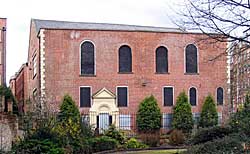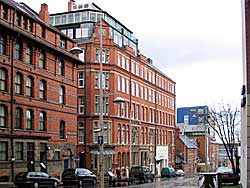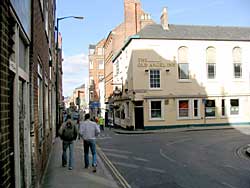< Previous | Contents | Next >
Barker Gate, Count Street and Woolpack Lane

St Mary's School was originally built as a Baptist chapel in 1799 and converted into a school by the architect T C Hine in 1886. The space in front of the building is a former burial ground of St Mary's church (A Nicholson, 2004).
The building used as St. Mary's School was erected in 1799 by the General Baptists. After the Wesleyans had built Hockley Chapel they sold the Octagon to the General Baptists, and that body continued to worship there till they found themselves in a position to erect this really rather handsome structure. In 1817 it was the scene of a most remarkable occurrence. The Rev. Robert Smith was assisted in his ministrations by the Rev. W. Catton. Mr. Catton's popularity with the congregation seems to have upset Mr. Smith, and led to so much bad blood that at last, after trying all sorts of ways to smooth the matter over, the congregation decided to discharge both of the ministers. However, the chapel trustees were not of this way of thinking and a majority of them decided to support Mr. Smith. The upshot was a most unseemly brawl on Sunday, August 3rd, 1817. The congregation arranged with a Mr. George to conduct the service, and at an early hour he took possession of the pulpit surrounded by friends determined to protect him. A dozen stalwarts sat on the pulpit stairs as a bodyguard. The service had only just begun when a special constable arrived, and after in vain charging Mr. George to come down from the pulpit he forced his way up the stairs and arrested the preacher. However, the service eventually proceeded.

View down Barker Gate towards the Ice Stadium (A Nicholson, 2004).
At the afternoon service the Rev. Mr. Smith presented himself in company with a few friends and four policemen, and demanded the pulpit. His demand was refused, and after a certain amount of argument the policemen were instructed to clear Mr. George and his partisans out of the pulpit. Turmoil ensued, and at last Mr. Smith was installed in the pulpit amidst the hisses of the congregation. This led to a disruption of the church, and eventually Mr. Smith and his followers built themselves a chapel in Broad Street, and the Rev. William Pickering became minister of the chapel we are considering. He must have been successful in his labours, for in spite of the secession of Mr. Smith's followers it was found necessary to enlarge the chapel in 1834.
Barker Gate is part of one of the oldest roads of Nottingham, being a section of the pre-historic track joining east to west that coasted along the high lands north of the Trent. It was via Barker Gate that in 1645 was established the first regular Royal Mail service between Nottingham and London. The mails left the Great North Road at Newark, and after getting over the Trent at Stoke Ferry arrived at Nottingham via Carlton Hill.
So far back as 1325 Barker Gate is referred to as "Vicus Tannatorum," the street of the Tanners, and indeed "Barker" is merely another name for "Tanner." We have seen, when considering the later history of the Nottingham Tanners, that although they appear to have early settled in Barker Gate near the Beck they moved to Narrow Marsh to get in touch with the Leen.
Maiden Lane in London is a colloquialism for "Midden" Lane, but this does not seem to apply to the Nottingham thoroughfare, which under a series of names such as "Maiden Lane" and "Fair Maiden Lane" goes back to remote past.
Upon the site now occupied by St. Mary's Institute stood Salem Chapel. It was one of the many "Independent" chapels erected in the early days of Nonconformity and was built in 1818 at a cost of £2,000 by a Mr. Butcher, who acted as minister in a voluntary capacity. Afterwards it was served by Rev. W. Orange, but as the congregation was rather poverty-stricken, and as there was a debt of some nine hundred pounds, the cause was abandoned and the buildings taken over by the creditors. It was sold to a sect called the Arminian Methodists. By 1839 they, too, appear to have been in difficulties, and the place was bought by Mr. J. Hine and Mr. J. Wallis who transferred it to a sect of Baptists worshipping under the title of New Testament Disciples. According to the date stone, the present building was erected in 1874.*
Behind these buildings is a small burial ground of St. Mary's parish which was called "Paradise," a very usual name for burial grounds in bygone days which has given rise to the many "Paradise Streets," Paradise Places" and so forth, which one can find scattered throughout the country.
Count Street was called Palavicini's Row in 1750, in memory of the Italian of that name who, in the XVIII. century, conducted a glass and pot manufactory in the neighbourhood, as we saw when considering Carter Gate. It is a comparatively late thoroughfare breaking through the town fortifications.

The Old Angel Inn on the corner of Stoney Gate and Woolpack Lane (A Nicholson, 2004).
Woolpack Lane is an almost modern name for an ancient road which used to be called Newark Lane. The name of "Newark Lane" has migrated in a very confusing manner, for in addition to being applied to Woolpack Lane it was at another time the name given to what we now call Sneinton Street, and it is used nowadays for an unimportant passage between Sneinton Street and Count Street.
On the northern side of Woolpack Lane is a fine old house, whose garden is now used as a timber yard. It looks as if it ought to have a story, but beyond its general Georgian appearance I know nothing of it. Just below this house is Mill Alley, which is somewhere near the site of Hockley mill built by Arkwright and his partners in 1768. Arkwright was an itinerant dealer in hair, living at Preston. He invented a process of spinning cotton by passing it through rollers, and fearing mob violence he followed Hargreaves to Nottingham. After some little difficulty, a partnership was arranged between him and the great hosiery firm of Need, Strutt & Woollatt, and this Hockley mill was built. Its machinery was driven by horse-power, but as this proved both costly and ineffective the business was transferred to Cromford, where water-power was readily obtainable, and the Cromford Mills erected in 1771. Arkwright's mill was burned in 1781, and I believe no trace of its actual fabric remains.
In 1718 William Ayscough moved his printing press into Woolpack Lane. He had established himself in Bridlesmith Gate, somewhere about midway between Pepper Street and St. Peter's Gate in 1710. This was the first printing press to work in Nottingham, and Ayscough's business must have been extensive for he worked for booksellers in London, Leeds, Sheffield and Derby.
* CORRECTION: Paul Dover has pointed out that 'Salem Chapel was in use until 1882 when the church moved to Long Hedge Lane (see the "History of the Church of Christ Meeting at Long Hedge Lane” by S. Mottershaw and published in 1886) and the building was sold and Gothic House erected on the site.' (APN, 17/8/2014).
